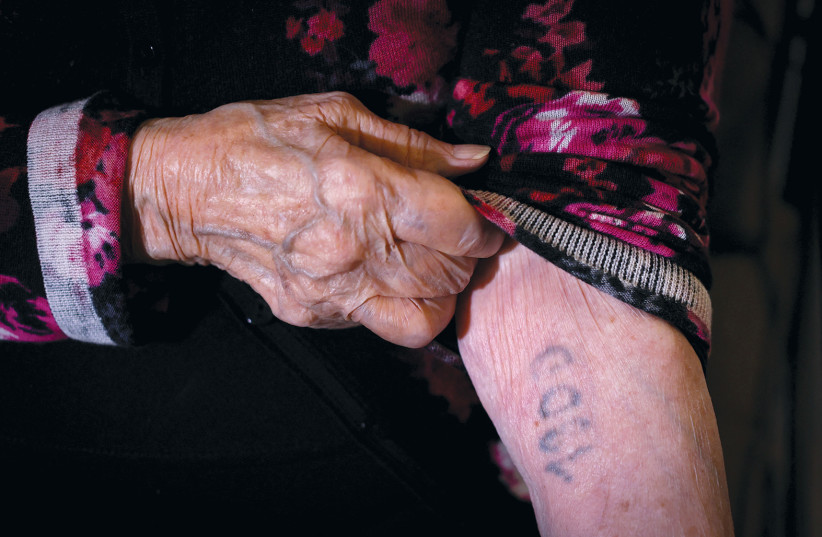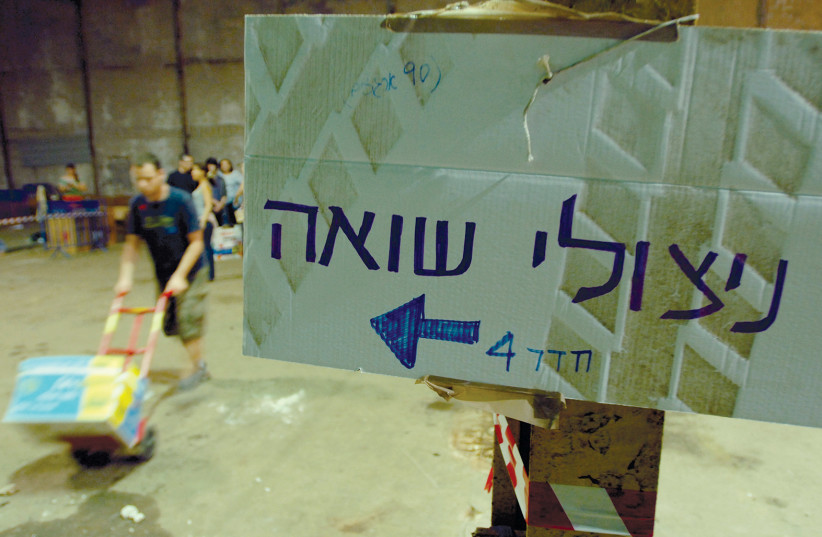Every year, the ritual repeats itself: Large ads call on the public to donate to organizations that support Holocaust survivors, who must make the excruciating choice between food or medication.
Usually, the ads, often appearing around Holocaust Remembrance Day, are accompanied by poignant pictures of the faces of survivors, who look hungry, exhausted and on the verge of despair. The ads’ underlying message is that the state ignores the dwindling numbers of Holocaust survivors, and that in addition to their abject poverty, they suffer from severe loneliness.
There are questions that arise. Are there indeed Holocaust survivors in Israel who go hungry? If so, who is responsible for that shameful situation? Who are these survivors, and why aren’t they supported sufficiently by the state? What is the role of the charitable organizations that, year after year, raise funds to feed these survivors? Shouldn’t that be the state’s responsibility?
The answer is complex. Survivors initially were considered those who lived through the European concentration camps and ghettos, were recognized as Holocaust survivors, and lived in Israel until 1953, the year following the reparations agreement with Germany.
In the early 1990s, the definition was expanded to include the Jews of Tunisia, Algeria and Morocco, since in those countries both the French Vichy regime, which collaborated with the Nazis, and the Nazis themselves, who stayed in those countries for months, sent Jews to forced labor camps in Germany, many of whom never returned.

TODAY, THERE are close to 10,000 Holocaust survivors living in Jerusalem. The municipality operates an array of diverse programs and welfare projects for them. The programs include a variety of social, leisure and cultural activities, as well as support initiatives that help them exercise their rights. These include 21 social clubs, which operate in cooperation with the Welfare Ministry; the social service departments; and the community administrations that provide services to approximately 650 participants.
Emphasis is made on alleviating loneliness, as well as improving physical and mental resilience. Options include classes, workshops, lectures, meals, trips and events that are held weekly. Some of these programs have been adapted to the specific backgrounds and cultures of the survivors.
Yossi Heyman, CEO of Joint-Eshel and former CEO of the Jerusalem Municipality, led a program in 2012 to locate Holocaust survivors in the city in order to offer them various forms of assistance. This includes informing them of their rights; addressing their emotional and psychological needs; alleviating loneliness; and allowing them to receive the full assistance available. Language limitations prevented many from knowing what is available to them, according to Heyman, who added that other municipalities have adopted the Jerusalem model.
The Supportive Community program, which grants subsidies to 1,100 Holocaust survivors in Jerusalem, offers a basket of services to veteran survivors. They can participate in social activities, as well as receive a distress button and service from a community leader, who maintains regular contact with them and helps in emergency situations and in carrying out minor repairs in their homes.
In the home care program, professionals make weekly visits to 300 survivors who are confined to their homes. Volunteers also provide memory exercises, occupational and physical therapy, art therapy, gymnastics, Feldenkrais, help with grooming and more.
During the year, the Jerusalem Municipality, in cooperation with social services departments and the community administrations, provides vacation programs for survivors. These include hotel accommodations and daily tours to various sites in Jerusalem and outside the city.
Holocaust survivors in Jerusalem are entitled to free personal counseling, provided by lawyers from the Aviv Association for Holocaust Survivors, to learn how they can exercise their rights. As part of the program, special radio channels are operated in the homes of approximately 200 Holocaust survivors, which help alleviate their loneliness. These local channels broadcast regular community meetings, where various lectures and classes are delivered in different languages throughout the week. The Holocaust Survivors’ Welfare Fund, as well as the Jerusalem Fund, also provide services and activities for survivors.
Nevertheless, the difficulties experienced by the Holocaust survivors are numerous. Many survivors are not aware of the resources available or their rights.
“We do everything to reach out to them, but sometimes we fail despite all our efforts.”
Gil Ribush

Who are the Jerusalem survivors in need?
Gil Ribush, director of community and welfare services at the municipality, is aware that some survivors can fall through the cracks and remain outside the loop of services. This is due to a lack of awareness of the services that his office provides, the language barrier, and the psychological state of many survivors, which leads some to be disconnected from society.
“We do everything to reach out to them, but sometimes we fail despite all our efforts,” he observes.
He enumerates the options for survivors, such as assistance from the National Insurance Institute, community centers, seniors clubs, health insurance funds, municipal welfare services and sometimes neighbors. “The main problem is with elderly Holocaust survivors who do not speak Hebrew and have no family members here,” he says.
Another issue is the mental state of survivors, who lived through traumatic events, causing many to feel vulnerable and anxious. Psychologists who work with survivors believe this is what has prevented them from claiming their rights.
All those who deal with the survivors agree that immigrants from the FSU are mainly affected; and more recently, those who fled since February 2022 from Ukraine and Russia following the outbreak of the war in Ukraine. Many have not been identified, and they do not benefit from any pension from their country of origin. They live on small allocations provided by Israel, which, in most cases, do not enable them to live in decent conditions.
“All the elderly who need the food baskets provided by these organizations are immigrants from the Soviet Union who immigrated to Israel and are not entitled to an allowance – only immigrants until 1953 are eligible,” admitted an employee of a Jerusalem charity organization.
The source added, “There are no agreements between Israel and Russia to enable these persons to receive their modest pensions once they immigrate to Israel. Therefore, they flee the war there, but they arrive here with close to zero income.” ❖
Who are the survivors?
There are currently 165,800 Holocaust survivors living in Israel, according to the Welfare and Social Affairs Ministry. On average, 42 survivors die daily. The data shows that 90% of the survivors are over 80, with an average age of 85. Nineteen percent of them, about 31,000, are over age 90; more than 950 have passed the age of 100.
Sixty-four percent were born in Europe; the largest group, 59,900, are from the former Soviet Union (36%). Twelve percent (19,100 survivors) come from Romania; 8,900 lived in Poland (about 5.5%); 4,500 from Bulgaria (2.7%); 2,400 from Hungary (1.5%); and 2,300 hail from Germany.
Of those from Asia and North Africa, 30,600 are from Morocco and Algeria and suffered antisemitic harassment and various restrictions during the Vichy regime. Some 18,000 (11%) are Baghdad Jews who survived the June 1941 Farhud riots in Iraq. About 7% (11,000) are Tunisian and Libyan veterans who suffered from the racial laws and were sent to forced labor camps during World War II.
For more information, visit mof.gov.il/hrights.
